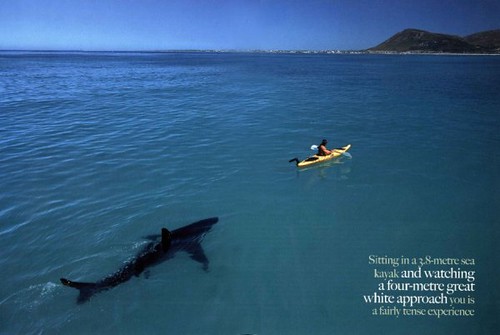While northern-hemisphere inhabitants are enjoying their first day of winter, our cousins in the southern hemisphere are just beginning summer. And in South Africa’s Shark Bay, near Gansbaai, the great whites are departing for other waters.
The great whites make their way to Shark Bay annually between September and January, though they are not hunting, and, as Rob Mousley reports, they “ignore bait slicks (and bathers), swimming through them without any reaction–in contrast to their behaviour at other locations such as Dyer Island” [link added].
Thomas P. Peschak and Michael C. Scholl began using kayaks to join the sharks in shallow waters (sometimes as shallow as 2 meters) where their research vessel couldn’t go. Testing showed the sharks cared little — “the sharks would circle the kayak and look at it, but they never tested it with their teeth.”
Michael is quite happy now to paddle with the sharks especially as the sea kayaks seem a minimally invasive platform from which to do so. Individual sharks sometimes circle the kayak, and will occasionally lift their heads out of the water to take a better look, but subsequently ignore the kayak altogether allowing the researcher to follow closely behind.
When asked what a paddler should do if a shark is sighted, Michael said, “First and foremost, enjoy the moment!”
Andre Hartmann, commercial fisherman and de facto shark tour guide enjoys grabbing their fins. From Jean-Michel Cousteau’s Ocean Adventures:
Jean-Michel and Andre snorkel near the surface, a very vulnerable position because great whites tend to feed from the sea floor up. An enormous great white advances, and the divers are careful not to provoke it. There is a waiting game. Eventually, the shark allows the divers to touch it. Then, amazingly, unlike its terrifying man-eating reputation, the great white allows the divers, one at a time, to grip its dorsal fin and be taken for a ride through the clear blue waters.
